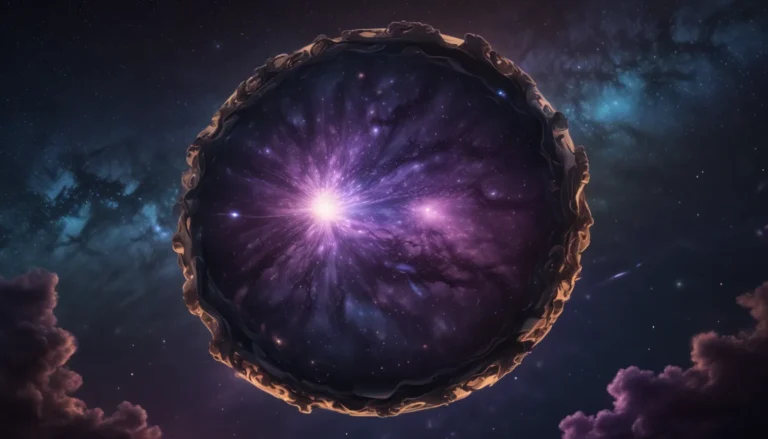The pictures we use in our articles might not show exactly what the words say. We choose these pictures to make you interested in reading more. The pictures work together with the words but don’t take their place. The words still tell you the important facts.
Dark matter, a mysterious and enigmatic substance that exerts gravitational influences on visible matter, continues to captivate researchers in the field of astrophysics. Among the many facets of dark matter that intrigue scientists, self-interactions stand out as a particularly fascinating subject. In this article, we will explore eight surprising facts about dark matter self-interactions, shedding light on the complex dynamics that shape the invisible realm of dark matter.
The Enigma of Dark Matter Self-Interactions
Despite decades of research, the exact nature of dark matter self-interactions remains shrouded in mystery. Scientists believe that dark matter particles interact with each other through an unknown force, opening up a realm of intriguing possibilities for further exploration.
Influencing the Universe’s Structure
Self-interactions of dark matter could have a profound impact on the distribution of dark matter throughout the universe. By influencing how these particles interact and cluster together, self-interactions play a crucial role in shaping the large-scale structure of the cosmos.
Solving the “Small-Scale Crisis”
A discrepancy in simulations of dark matter behavior on different scales, known as the "small-scale crisis," hints at the possibility of self-interactions on smaller scales. These interactions could provide a key to resolving the puzzle and advancing our understanding of dark matter dynamics.
Unlocking Galactic Dynamics
The rapid rotation of galaxies, a phenomenon that defies predictions based on visible matter alone, can potentially be explained by self-interacting dark matter. These interactions generate gravitational forces that align with observed rotational speeds, offering a new perspective on galactic dynamics.
Implications for Dark Matter Halos
Dark matter halos, expansive invisible regions that envelop galaxies, may be significantly influenced by self-interacting dark matter. Understanding these interactions can unveil the intricate relationship between dark matter and visible matter in the formation and evolution of cosmic structures.
Impact on Detection Experiments
The presence of self-interactions in dark matter poses implications for experimental detection efforts. Researchers exploring the mysteries of dark matter must consider these interactions when designing detectors and analyzing data to uncover potential evidence of this elusive substance.
Bridging Beyond the Standard Model
Studying dark matter self-interactions provides a gateway to exploring particle physics beyond the boundaries of the Standard Model. By gaining insights into fundamental particle properties and potential new interactions, scientists can expand their understanding of the underlying framework of the universe.
Shaping Cosmic Evolution
During the early stages of the universe's evolution, self-interactions of dark matter may have played a pivotal role in determining the fate of cosmic structures. These interactions offer a key to deciphering the intricacies of dark matter's role in shaping the universe as we know it.
Conclusion: Unraveling the Universe’s Mysteries
In conclusion, delving into the realm of dark matter self-interactions has unveiled a host of remarkable insights into the mysteries of the universe. These surprising facts challenge our existing knowledge and beckon us to embark on further exploration and discovery. By understanding how dark matter interacts with itself, scientists move closer to unraveling its properties and unraveling its profound impact on the cosmos.
FAQs
Q: What are dark matter self-interactions?
A: Dark matter self-interactions refer to the interactions between dark matter particles, influencing their behavior and distribution in the universe.
Q: Why study dark matter self-interactions?
A: Understanding these interactions provides crucial insights into dark matter's properties, behavior, and impact on cosmic evolution.
Q: What surprising facts exist about dark matter self-interactions?
A: Surprising aspects include dark matter forming dense structures, influencing galactic dynamics, and impacting the distribution of dark matter halos.
Q: How do scientists study dark matter self-interactions?
A: Scientists use simulations, mathematical models, observational data, and experimental observations to explore these interactions.
Q: Is our understanding of dark matter self-interactions complete?
A: The study of dark matter self-interactions is ongoing, with many aspects still unresolved as researchers delve deeper into this fascinating field.
Embarking on the journey of understanding dark matter self-interactions opens a gateway to a universe filled with awe-inspiring wonders and mind-bending discoveries. For those curious minds eager to explore the mysteries of the cosmos, the world of astrophysics offers a wealth of captivating challenges and revelations. Stay curious, stay informed, and let the exploration of dark matter self-interactions ignite your passion for unraveling the secrets of the universe.






